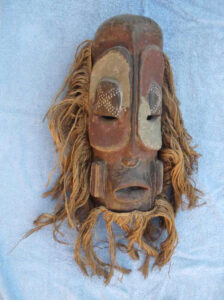How to Sell a Bapende Mask?
 Frightening yet beautiful, this wooden and polychromed (painted with many colors) carved Bapende mask from Zaire belongs to a group collected by a world-famous celebrity. The current owner asked, “Where can I best sell these masks?” Indeed this collection is superb and varied.
Frightening yet beautiful, this wooden and polychromed (painted with many colors) carved Bapende mask from Zaire belongs to a group collected by a world-famous celebrity. The current owner asked, “Where can I best sell these masks?” Indeed this collection is superb and varied.
The late wife of a reader purchased the masks in the early 1980s in Nairobi, Kenya, from the collection of actor William Holden. Holden’s partner, Stefanie Powers, sold the masks to benefit The William Holden Wildlife Foundation, which she created after his death. The foundation still operates as an educational facility in Kenya. The Academy award-winning actor amassed a world class collection of masks, one of which ended up donated to the Palm Springs Art Museum in 1982.
Cultural Sensitivity of African Masks Collected During Colonial EraCapitalistic colonizers, French, English, and Belgian dealers acquired many in the 1920s. They realized the market potential of the taste for the exotic and the growing understanding of the abstract nature of modern art, conceptualized by artists such as Klee and Picasso.
The collection amassed by Holden (1918-1981) was known for its connoisseurship. He co-founded the Mount Kenya Safari Club (1959) and established a game ranch focused on wildlife preservation. As he grew older he became increasingly concerned with various animal species declining in population.
Another mask in the group is a Baule mask from the Ivory Coast. In the 1980s I served in the Peace Corps and took long weekends in the Ivory Coast. The Baule people inhabited the east side of the Ivory Coast, part of the Akan people of West Africa’s Ghana and the Ivory Coast, known for their gold talismans, brass castings, and wooden figural sculptures. Their masks are their foremost art form. I purchased mine in the mid 1980s and it hangs on a white wall in front of my desk.
During the last half of the 19th century to the first quarter of the 20th century, only an important individual from a powerful family owned such a Baule mask. When worn, the soul of the mask is transmuted through the “dancer’s” face. He, dancers were always male, transformed into the representation of the mask. He became a deity, an ancestor, or animal spirit. The mask allowed the spiritual world to interact with the physical world, facilitating communication between ancestors and heirs, humans and deities, humans and animals, low born villagers and high born, men and women, earth and sky.
Two Divine Beings at the Heart of Baile SpiritualityThese are the creator god Nyamien, and Asie, the God of the Earth, lord of humans and animals. The soul is immortal, and therefore beholden to its ancestors.
The mask pictured is a portrait mask and might depict a forebearer of the dancer. This mask shows the physical features of an honorable person: the slit-eyes represent modesty, the open mouth and folds, age, the hair and beard wisdom.
Let’s imagine this mask “danced” in a ceremony in the early 1900s. Before the ceremony this mask may have been kept “sleeping” in a personal shrine until its command performance in a “masquerade.” The masker or dancer wears a fiber costume, and danced to drums, to singing, and spoken words. The mask became the actor in a skit and the actor became the mask.
Here’s the cultural conundrum and why the sale of these masks is a delicate topic. Although this mask is a stunning three-dimensional work of art, the mask wasn’t intended as a wall-hanging. Why? The mask initiated movement. The mask holds the power to act, and to remain static on a wall belies its power. I’m to blame as well. My Baule mask is on my wall as I write this. I “see” form, color, texture, and abstraction of the human face. I KNOW I should feel, as did the Baule masker/dancer in 1900, its power of action and creation.
The static, formal properties of the mask “create” value for it in the European and US marketplace; the mask, if sold at auction, would realize over $2,000. I would suggest Skinner Bonhams auctions for the sale of such a mask.
The post How to Sell a Bapende Mask? appeared first on Elizabeth Appraisals.
Elizabeth Stewart's Blog
- Elizabeth Stewart's profile
- 5 followers



